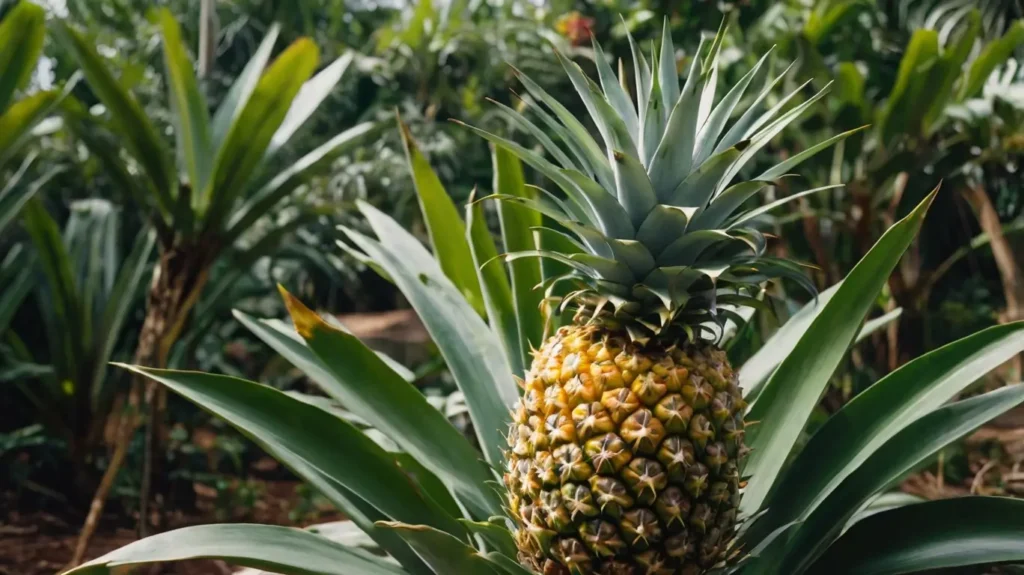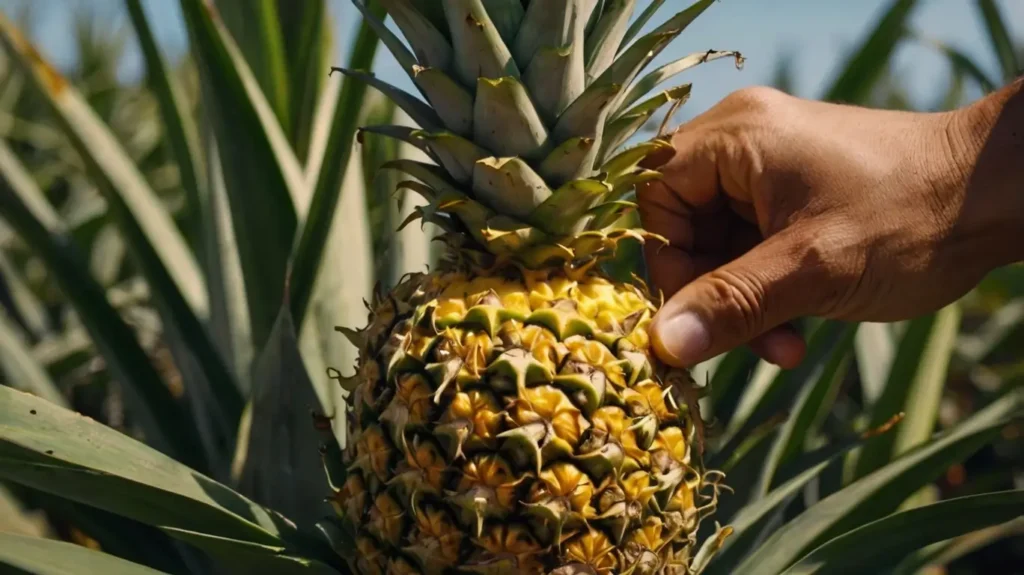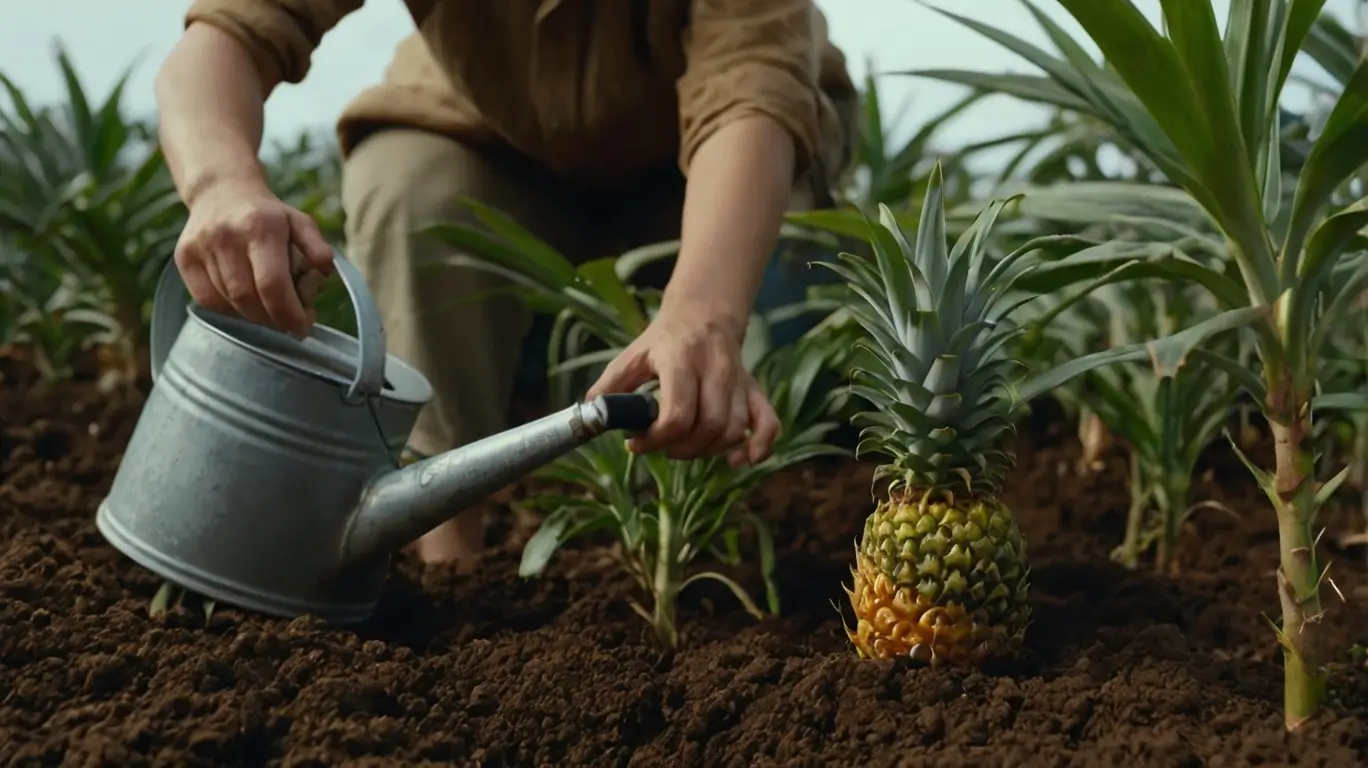Pineapple Plant Care: The Ultimate Guide for Happy Plants in 2025
Introduction: Start Your Pineapple Journey Right
Ever dreamt of growing your own pineapple at home? You’re not alone! The thought of plucking a fresh, homegrown pineapple from your own backyard—or even your kitchen—is an exciting prospect.
When I first started growing a pineapple plant, I was curious and admittedly a bit skeptical. After all, this tropical fruit is typically associated with exotic, sun-drenched islands, not your average living room or garden.
But with a little bit of patience and the right care, my pineapple plant not only thrived, but it also produced one of the sweetest, most satisfying fruits I’d ever tasted.
If you’ve been wondering how to start your own pineapple journey, let me reassure you: it’s not as difficult as it seems. In fact, with the right pineapple plant care, you’ll soon be enjoying the lush greenery and potential fruiting of your own pineapple plant.
It’s all about understanding the needs of the plant, such as the right amount of sunlight, water, and a bit of tender loving care.
In this guide, we’ll walk through the essentials of pineapple plant care, from planting and watering to troubleshooting common problems.
You’ll learn all the tips and tricks necessary to create the ideal environment for your plant to thrive, ensuring you’re not only nurturing a healthy, vibrant pineapple plant but also setting the stage for the exciting reward of homegrown fruit.
Ready to begin your pineapple-growing adventure? Let’s dive into the world of pineapple plant care and get you on the right track for success!
What You Need to Know About Pineapple Plants

When you think of a pineapple, you might picture sandy beaches and warm, tropical climates. The truth is, pineapple plants (Ananas comosus) are native to the tropical regions of South America, but they’ve since spread across the globe.
These fascinating plants aren’t just iconic for their sweet, golden fruit—they’re also quite unique in terms of their growth and appearance, making them an ideal addition to any home garden or indoor space.
The Origins of the Pineapple Plant
Pineapple plants hail from the tropical regions of South America, specifically Brazil and Paraguay, where they grow in the wild.
They thrive in warm, sunny climates, which is why they’re most commonly found in places like Hawaii, the Caribbean, and other tropical and subtropical zones.
However, with the right care and environment, pineapple plant care is possible even in non-tropical climates—making them an excellent choice for indoor gardening or for home gardeners who want to bring a touch of the tropics into their homes.
Unique Characteristics of Pineapple Plants
What makes pineapple plants so distinctive is their striking appearance. With long, spiky leaves that form a rosette at the base, the plant looks almost like a giant succulent. The leaves are tough and fibrous, which helps the plant conserve moisture in its natural environment.
One of the most interesting aspects of growing a pineapple plant is how its fruit grows: it starts as a small flower cluster at the top of the plant, which eventually matures into the familiar large, spiky fruit we all recognize.
Not only are pineapple plants beautiful to look at, but they also have a functional and versatile role in the home. They can be grown indoors as an ornamental plant, thriving on a sunny windowsill, or outdoors in warmer climates.
Whether you’re into indoor gardening or you prefer growing plants in your backyard, a pineapple plant adds an exotic touch to any space.
Why Pineapple Plants Are Perfect for Home Gardening
While pineapple plants are often thought of as a tropical garden project, they’re actually quite adaptable and can be successfully grown indoors with proper care. Unlike many plants that require specialized conditions, pineapples don’t demand much.
This makes pineapple plant care an excellent option for beginners or gardeners looking for a relatively low-maintenance plant.
When growing pineapple plants indoors, you can create a tropical vibe by placing them near bright windows where they’ll get plenty of sunlight.
And if you’re an outdoor gardener, planting them in well-draining soil with ample sun exposure will help them thrive. With the right balance of light, water, and nutrients, your pineapple plant care routine will set you up for success.
In summary, pineapple plants are a unique and versatile addition to any home, whether you’re growing them indoors or outdoors.
Their distinct look, ease of care, and the reward of harvesting your own fruit make them a worthwhile investment for any gardener. Whether you’re new to home gardening or experienced in the world of plants, learning how to properly care for your pineapple plant is a fulfilling and fun journey.
So, now that you know a bit about where pineapple plants come from and why they’re a great choice for your space, let’s move on to the next step: providing the right environment for your plant to thrive!
The Best Environment for Your Pineapple Plant
To help your pineapple plant thrive, creating the right environment is crucial. Whether you’re growing an indoor pineapple or cultivating it outside in a warmer climate, understanding the ideal pineapple growing conditions is essential.
Pineapple plant care revolves around providing the right balance of light, temperature, and humidity, which are all key factors in ensuring your plant’s success. Let’s break down these important aspects one by one.
Light Requirements for Pineapple Plants
When it comes to pineapple plant care, light is one of the most important factors to consider. These tropical plants crave sunlight, and ensuring they receive the right amount is crucial for their growth. Pineapple plants need full sunlight—at least 6 to 8 hours per day—to thrive.
If you’re growing an indoor pineapple, it’s vital to place it in a spot where it will get plenty of direct sunlight, such as near a south-facing window. If your home doesn’t get enough sunlight, you can supplement natural light with grow lights designed for tropical plants.
Temperature and Pineapple Plants
Pineapple plants are quite particular when it comes to temperature. They thrive in warm conditions, making them perfect for indoor environments where temperatures can be controlled.
Ideally, you want to maintain temperatures between 65°F (18°C) and 95°F (35°C). If you’re growing your pineapple plant indoors, ensure your home stays within this range, especially during colder months.
If your house gets chilly, you might need to move the plant to a warmer spot, such as near a heat source, or use a space heater to maintain an optimal environment.
It’s important to note that pineapple plants are sensitive to frost. They will not survive temperatures below 32°F (0°C), so if you’re growing them outdoors in cooler climates, you’ll need to bring them inside during the colder months.
Humidity Needs for Pineapple Plants
Like many tropical plants, pineapple plants prefer higher humidity levels, which is another essential part of pineapple plant care.
In their native environments, they grow in humid conditions, so providing your plant with similar levels of moisture in the air can help it thrive. Ideally, the humidity around your pineapple plant should be around 50% or higher.
If you’re growing your pineapple plant indoors, you can easily increase the humidity by misting the leaves occasionally.
Alternatively, placing a humidifier nearby can help keep the air moist, especially during dry seasons or in air-conditioned rooms.
Be cautious not to overdo it, as excessively wet conditions can lead to fungal issues. If you’re growing your pineapple plant outdoors, the natural humidity in tropical regions will usually be sufficient, but it’s always a good idea to keep an eye on your plant during particularly dry spells.
Bullet Points: Key Environmental Conditions for Pineapple Plants
- Temperature: Keep your pineapple plant within the range of 65–95°F (18–35°C).
- Light: Ensure the plant gets 6-8 hours of full sunlight each day. If grown indoors, place it by a sunny window.
- Humidity: Aim for 50% or higher humidity, and consider misting or using a humidifier to maintain moisture in the air.
By maintaining these key conditions for your pineapple plant, you’ll help it grow strong and healthy. Providing the right amount of light, keeping the temperature steady, and ensuring the plant enjoys adequate humidity will set the stage for a thriving, happy pineapple plant.
Whether you’re cultivating an indoor pineapple or growing it outdoors, these environmental factors are the foundation of good pineapple plant care.
Now that you understand how to create the perfect environment for your pineapple plant, it’s time to focus on the next step: planting and nurturing your pineapple to ensure it grows to its full potential. Stay tuned!
Planting Your Pineapple: The First Steps
If you’re ready to take the plunge into pineapple plant care, planting your pineapple properly is the first crucial step. Whether you’re starting with a fresh pineapple crown or a small baby plant, choosing the right container and soil will provide your plant with the best possible environment to grow.
Let’s dive into the essential steps for pineapple planting and get your tropical friend off to a strong start.
Choosing the Right Container and Soil

For pineapple planting, container size and soil quality are vital factors. When selecting a container for your pineapple plant, aim for one that’s at least 8–12 inches wide. This gives the plant enough space to grow and spread its roots comfortably.
It’s also essential to ensure the container has drainage holes at the bottom. Pineapple plants don’t like their roots sitting in water, which can lead to root rot. Good drainage is key to pineapple plant care and helps prevent waterlogged soil that can harm the plant.
When it comes to soil, opt for a well-draining mix. Pineapple plants prefer slightly acidic soil with a pH between 5.5 and 6.5.
A good mix for pineapple plant care can consist of a blend of potting soil and sand or perlite, which enhances drainage and air circulation around the roots.
If you’re unsure about soil, you can also purchase potting soil specifically formulated for tropical plants, which will meet the needs of your pineapple plant.
Steps for Planting
- Select a Container: Choose a container with adequate drainage holes. The size should be at least 8–12 inches in diameter to give the roots plenty of space.
- Prepare the Soil: Fill the container with a well-draining potting soil mix, adding some sand or perlite for better drainage.
- Plant the Pineapple Crown: Gently cut the crown (top part) of a ripe pineapple, leaving a small section of the fruit attached. Remove the lower leaves and let the crown dry out for a couple of days to prevent rot. Insert the dried crown into the soil, burying the base of the leaves about 1–2 inches deep.
- Water Thoroughly: Once the crown is placed in the soil, water it thoroughly. Make sure the soil is evenly moist, but not soaked.
With these steps, you’ll be on your way to successful pineapple plant care. By choosing the right container and ensuring proper soil drainage, your plant will have a strong foundation to begin its journey.
How to Water and Fertilize Your Pineapple Plant
Proper watering and fertilizing are essential to keeping your pineapple plant healthy and thriving. While pineapple plant care doesn’t require a lot of fuss, understanding the right balance of water and nutrients will ensure your plant stays strong and produces fruit.
Watering Guidelines for Pineapple Plants
One of the most important aspects of pineapple plant care is ensuring you don’t overwater your plant. Pineapple plants are quite drought-tolerant and prefer their soil to dry out a bit between waterings. If the soil is consistently damp, it can lead to root rot, which is a common issue for indoor pineapple plants.
The rule of thumb is to water only when the top inch of soil feels dry to the touch. You can use your finger or a moisture meter to check the soil’s moisture levels. If the soil is still moist, hold off on watering for a few more days.
Always water thoroughly, making sure the water reaches the root system, but ensure that any excess water can drain away freely.
Bullet Points for Watering:
- Water when the top inch of soil is dry.
- Avoid waterlogging—ensure your container has drainage holes.
- Always water thoroughly, but make sure excess water drains out of the pot.
Fertilizing Your Pineapple Plant
Just like any plant, pineapple plants need nutrients to grow strong and healthy. Fertilizing helps provide those essential nutrients. However, pineapple plant care requires a gentle hand when it comes to fertilizing. Over-fertilizing can damage the plant, so it’s best to use a balanced, slow-release fertilizer.
Apply a balanced fertilizer (such as a 10-10-10 ratio) every 2-3 months to ensure your plant has the nutrients it needs. You can also opt for a fertilizer formulated for tropical plants, which will contain the right balance of nutrients for pineapple plants.
Be cautious not to apply too much fertilizer at once, as this can cause the plant to become stressed or develop nutrient imbalances.
If you’re growing your pineapple plant indoors, be especially careful, as indoor plants are more susceptible to over-fertilization due to the smaller growing space.
Fertilizing Tips:
- Use a balanced, slow-release fertilizer (e.g., 10-10-10 ratio).
- Fertilize every 2-3 months to keep the plant healthy.
- Don’t over-fertilize—too much fertilizer can damage the plant.
By following these watering and fertilizing guidelines, you’ll be giving your pineapple plant the best chance to grow strong and healthy.
Consistent and balanced care is the key to ensuring your pineapple plant stays vibrant and eventually rewards you with the fruit you’ve been waiting for.
With proper attention to watering and fertilization, your pineapple plant will flourish. In the next section, we’ll talk about common problems you might face and how to troubleshoot them, so you can keep your pineapple plant care routine on track.
Troubleshooting Common Pineapple Plant Issues

Even with the best pineapple plant care, there are a few challenges you might face along the way. However, with a little knowledge, these common problems are easy to manage. Let’s take a look at some of the most frequent issues you may encounter and how to solve them.
Common Pineapple Plant Problems
Pineapple plants can be susceptible to pests, diseases, and stress factors that can impact their growth. Here are a few issues to watch out for:
- Pests: Aphids, mealybugs, and scale insects are common pineapple plant pests that can cause damage. These pests suck the sap from the plant, leading to distorted growth, sticky residue, and yellowing leaves. Regularly inspecting your plant and treating it with insecticidal soap can help keep these pests in check.
- Yellowing Leaves: If you notice your pineapple plant’s leaves turning yellow, this may be a sign of overwatering or nutrient deficiencies. If the soil is too wet, it can lead to root rot, causing the leaves to yellow. On the other hand, a lack of essential nutrients can also cause similar symptoms. Adjust your watering habits and fertilize your plant with a balanced fertilizer to correct the issue.
- Leaf Browning: Brown tips or edges on your pineapple plant leaves can indicate dry air or inconsistent watering. Pineapple plants prefer higher humidity levels, and if the air is too dry, the leaves may start to dry out. Ensure consistent watering and consider increasing humidity by misting the plant or placing a humidifier nearby.
Troubleshooting Table
| Issue | Symptoms | Solution |
|---|---|---|
| Overwatering | Yellowing leaves, soggy soil | Water less frequently, ensure drainage |
| Pests (Aphids, Mealybugs) | Sticky residue, distorted leaves | Treat with insecticidal soap |
| Leaf Browning | Dry tips, brown edges | Increase humidity, water properly |
By understanding these common pineapple plant problems, you can take proactive steps to correct any issues and keep your plant healthy and happy.
How to Encourage Fruit Growth
One of the most exciting aspects of pineapple plant care is waiting for the moment when your plant begins to bear fruit. But how do you encourage pineapple fruiting, and how long does it take for this process to happen?
The Fruiting Process
For those of you eagerly anticipating the fruits of your labor (literally), be patient—it can take quite a while! Pineapple plants typically take about 18 to 24 months to bear fruit.
The timeline can vary depending on factors such as the plant’s age, environment, and the care you provide. While it may take time, the rewards are certainly worth it.
Step-by-Step for Fruit Growth
To help your pineapple plant fruit, ensure the following steps:
- Ensure Proper Sunlight: The plant needs plenty of direct sunlight to encourage fruiting. Place it in a spot where it can get 6-8 hours of full sunlight every day. An outdoor sunny spot or a south-facing window for indoor pineapple plants is ideal.
- Maintain a Warm Environment: Keep the pineapple plant in a warm, consistent environment. The ideal temperature is between 65°F and 95°F (18°C to 35°C). This will mimic its tropical origins and encourage healthy growth.
- Be Patient: It can take 18–24 months for your pineapple plant to bear fruit. During this time, continue with your regular pineapple plant care, and eventually, you’ll see that tiny fruit begin to develop at the top of the plant.
The key to getting your pineapple plant to fruit is consistency in care, and patience in waiting. As you nurture the plant, it will eventually reward you with its delicious fruit.
How to Harvest Your Pineapple
After months of care, your pineapple plant will eventually reach a point where the fruit is ready to harvest. But how do you know when it’s time to pick it, and what’s the best way to do so?
When and How to Harvest
The key indicators that your pineapple is ripe and ready to be picked are:
- Color: The pineapple should be a golden-yellow color, with the yellowing starting at the base and moving upward.
- Smell: A ripe pineapple will emit a sweet, fruity aroma near the base.
- Firmness: While the pineapple should be firm, it should give slightly when pressed gently.
To harvest your pineapple, use a sharp knife to cut the fruit from the plant. Leave about an inch of stem attached to the pineapple for the best appearance and to prevent damaging the plant.
Carefully cut through the stem and remove the pineapple.
Once harvested, you can enjoy your fresh, homegrown fruit, knowing that your dedication to pineapple plant care has paid off!
Common FAQs About Pineapple Plant Care
When starting out with pineapple plant care, it’s natural to have questions. Here are some of the most common inquiries we receive, along with helpful answers.
Frequently Asked Questions
How long does it take for a pineapple plant to bear fruit? Typically, it takes between 18 to 24 months for a pineapple plant to mature and bear fruit. The process can take a little longer depending on the plant’s environment and care.
Can I grow a pineapple plant indoors? Yes! Pineapple plants can thrive indoors with the right care. Make sure to place your plant in a spot with ample sunlight and maintain a warm, humid environment for the best results.
Do pineapple plants need a lot of water? No, pineapple plants prefer to dry out between waterings. Water only when the top inch of soil feels dry to the touch, and be sure not to overwater, as this can lead to root rot.
Conclusion: Your Pineapple Plant Success Awaits
Growing a pineapple plant can be a rewarding and exciting journey, especially when you see the fruit finally ripen after months of care.
Remember, pineapple plant care is relatively simple once you understand the plant’s needs—proper sunlight, warm temperatures, the right watering routine, and a little patience are all it takes.
So, don’t hesitate! Start your own pineapple-growing adventure today, and soon enough, you’ll be enjoying fresh, homegrown pineapple right from your own garden or windowsill.
Happy planting, and may your pineapple plant care journey be a sweet success!

